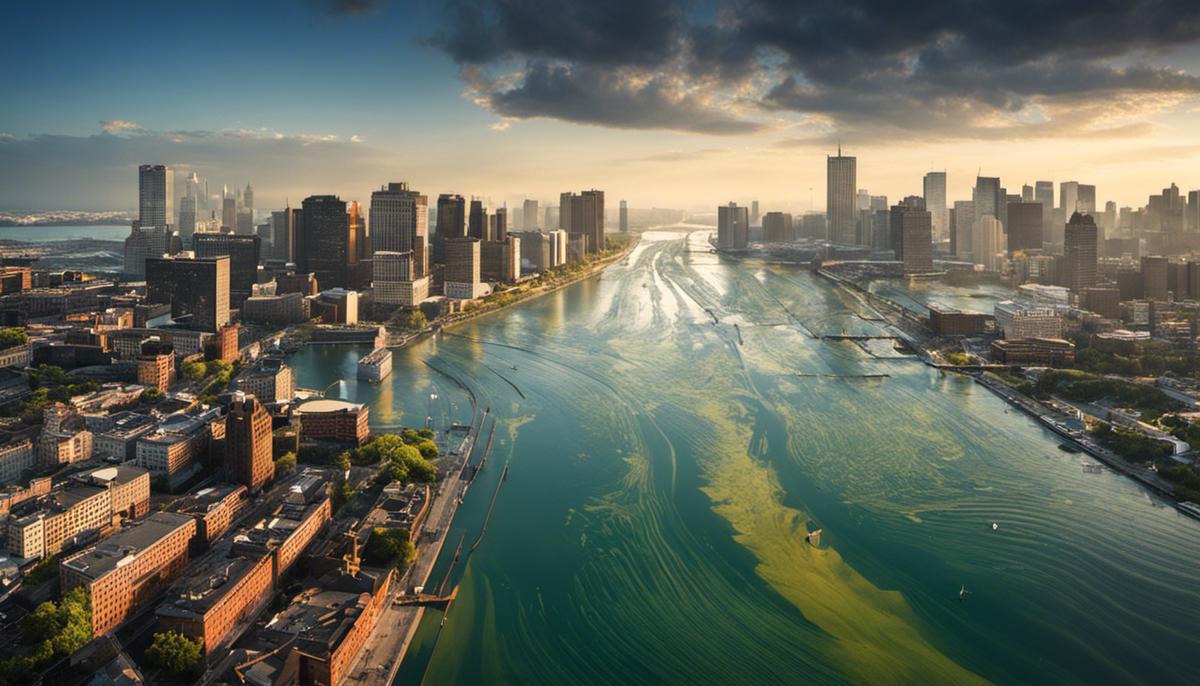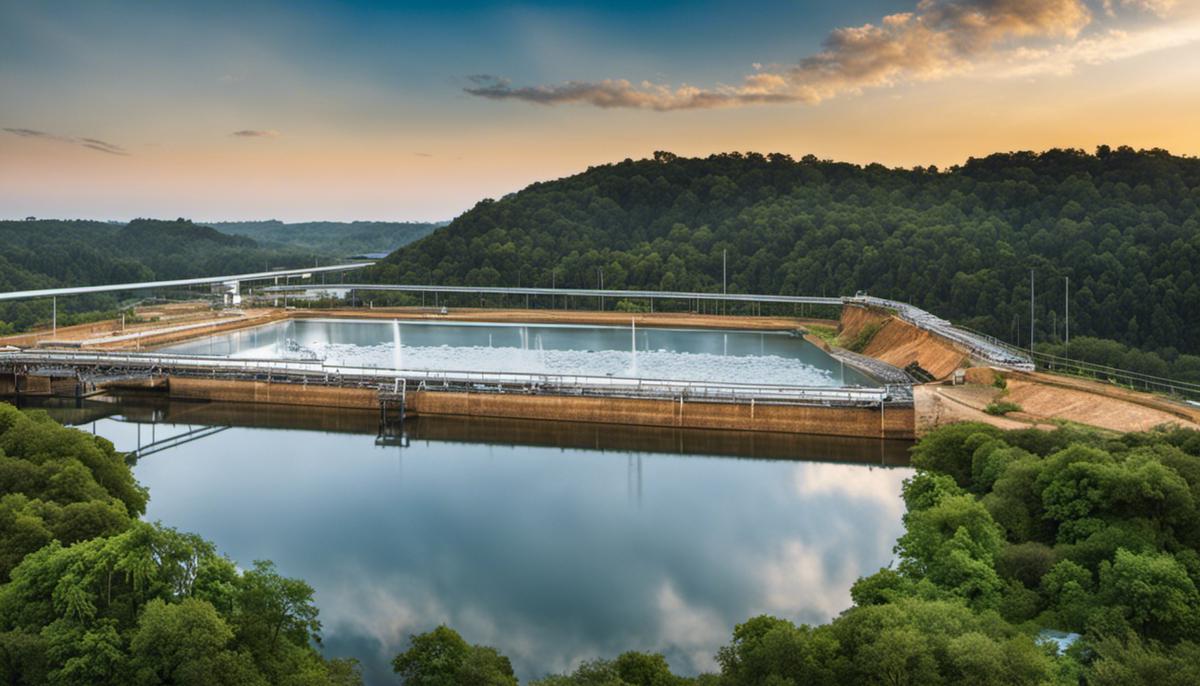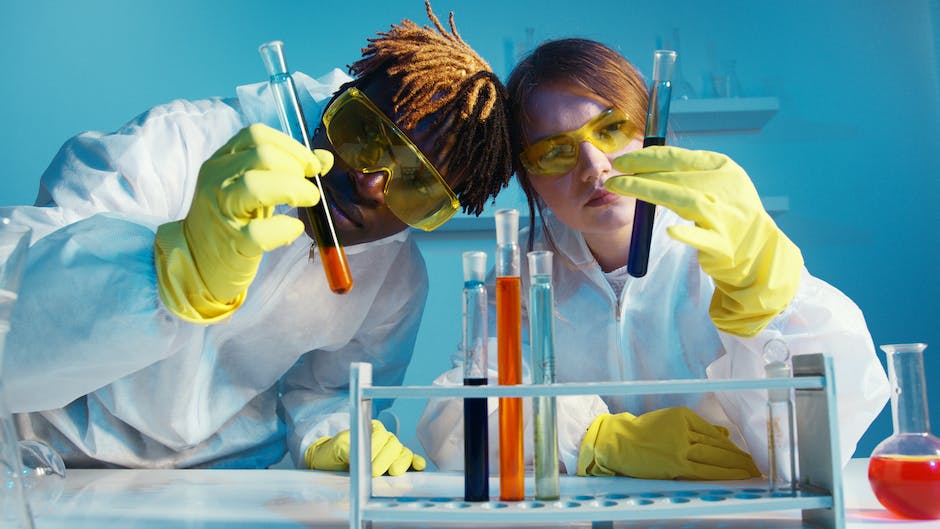In a world where clean and safe drinking water is a fundamental human right, the infiltration of toxins, both common and unexpected, into city water raises significant public health concerns. The presence of contaminants like harmful bacteria, heavy metals, industrial by-products, and even remnants of pharmaceutical compounds not only question the quality of water in our supply systems, but also expose the public to a range of adverse health effects. These risks magnify in vulnerable demographic groups like children and the elderly who may experience more severe outcomes as a result of prolonged exposure. Hence, understanding how we identify, manage, regulate, and educate about these invisible threats is vital.
Table of Contents
Identifying Toxins in City Water
The urban landscape and its resilience to environmental factors have been a focal point in scientific research for decades. Within this sphere, an aspect that has garnered significant attention pertains to the quality of city water and the array of potential contaminants it may harbor. Intriguingly, alongside common toxins, unforeseen contaminants have been identified, challenging pre-existing knowledge and provoking further investigation.
Primary amongst the recognized toxins in urban water bodies are lead, arsenic, mercury, and various chlorine byproducts. These contaminants chiefly originate from industrial effluents, pesticide runoffs, antiquated plumbing infrastructure, and disinfection processes employed in water treatment plants.
Lead, notably derived from old pipes, particularly threatens cognitive development in children, whereas arsenic, often released from industrial processes, can result in skin, bladder, and lung cancers, among other maladies. Mercury, both a natural earth element and industrial byproduct, targets the nervous system, posing considerable health risk. Lastly, chlorine byproducts, while necessary for eliminating microbial threats, can inadvertently lead to respiratory and digestive conditions.
Contrarily, recent studies have revealed less common, yet equally hazardous toxins lurking within city waters. These consist of pharmaceutical residues, microplastics, personal care products, and per- and polyfluoroalkyl substances (PFAS).
Pharmaceutical residues, often overlooked, enter the waste stream via human excretion or improper disposal, subsequently infiltrating water bodies. These substances can disrupt aquatic ecosystems and indirectly impact human health. Microplastics, microscopic plastic fragments, raise concern due to their capacity to absorb and release other pollutants. Meanwhile, personal care products, laden with chemicals like phthalates and parabens, are washed down drains daily, eventually tainting city water and posing ill-understood health threats.
PFAS, associated with non-stick cookware, fire-fighting foams, and various stain-resistant materials, have garnered recent concern due to their omnipresence and potential to foster adverse health outcomes such as endocrine disruption and cancer. Due to their intricate structural stability, these substances, often termed ‘forever chemicals,’ demonstrate unparalleled resistance to environmental degradation, rendering their extraction from water sources problematic.
Altogether, the complexities surrounding urban water toxicity represent a serious public health issue and a fascinating scientific challenge. It highlights the lacunae in current knowledge and the pressing need for holistic research regarding removal techniques, potential health implications, and prevention methodologies. Understanding these various toxins is crucial in progressing towards a sustainable future where clean, safe drinking water is not a privilege, but a universal right.

Health Impacts of Water Toxins
As we delve deeper into the topic of waterborne toxins and their possible health implications, it is essential to recognize the potential for lesser understood, but equally serious, health complications that can arise from exposure to such toxins. Research in this area, while extensive, is far from comprehensive – underscoring the need for continued vigilance and scientific exploration.
Radiological contaminants represent one such field of concern. Generated from certain types of industrial and agricultural practices, as well as natural processes such as the weathering of rocks, radiological contaminants such as radon, uranium, and radium can find their way into urban water sources. The presence of these contaminants in drinking water may contribute to increased risk of conditions such as anemia, cataracts, fractures and, in high concentrations, various forms of cancer.
The repercussions from exposure to cyanobacterial harmful algal blooms or CyanoHABs, which thrive in warm, nutrient-rich waters, are no less threatening. Toxins produced by these blooms can cause skin irritation, nausea, vomiting, and in serious cases, severe neurological disorders.
Another facet of waterborne toxins involves legionella, bacteria that can proliferate in untreated or inappropriately treated water systems, and can cause a severe form of pneumonia known as Legionnaires’ disease. Moreover, exposure to certain bacteria like E. coli, typically through fecal contamination, can result in gastrointestinal illnesses of varying severity.
Heavy pesticide exposure, often as a result of agricultural runoff, is another consideration. Persistent exposure to these chemicals can result in a wide range of health implications, including developmental difficulties, reproductive health problems, and numerous types of cancer.
The discussion on waterborne toxins would be incomplete without mentioning endocrine-disrupting chemicals (EDCs). EDCs, which include substances such as dioxin, DDT, PCBs, and other industrial components, interfere with hormonal systems, causing developmental, reproductive, neurological, and immune problems in both humans and wildlife.
Notwithstanding the above, it is important to acknowledge that the consequences of exposure to waterborne toxins are not restricted to direct health outcomes. There may be intricate indirect effects, such as those resulting from disruption of interconnected ecosystems, which in turn can impact human health by interfering with food chains or causing loss of biodiversity.
Efforts in mitigating the adverse health implications associated with exposure to waterborne toxins comprises a multi-faceted approach. These include improved detection mechanisms and treatment processes, robust monitoring systems, stringent regulations pertaining to industrial and agricultural waste management, public health initiatives for disease prevention and control, and fostering community awareness and participation in safeguarding water resources.
In essence, while we have made significant strides in understanding and addressing the health implications of waterborne toxins, there remains a vast universe to explore. Dedication to advancing our knowledge in this field is indeed a testament to human commitment towards ensuring an environmentally sustainable future with safe drinking water.

Toxins Removal and Water Treatment
Standard Water Treatment Methods and Unexpected Toxin Removal
Water treatment methods have conventionally been designed to efficiently remove common toxins like lead, arsenic, chlorine byproducts etc. Nonetheless, the question that naturally arises is the effectiveness of these methods in extracting unexpected toxins from water bodies.
Standard strategies to water treatment typically employ physical, chemical as well as biological procedures. These largely include sedimentation, filtration, disinfection, as well as the use of adsorption processes. While efficient for known contaminants, the efficacy of these methods for ‘unexpected’ toxins remains to be fully established.
Pharmaceutical residues — a byproduct of human and animal drug use — present in water sources pose significant challenges. Current water treatment does not fully eliminate them, leading to their potential bioaccumulation in aquatic organisms and possible ripple effects on human health.
In the case of microplastics, the size of these particles poses a considerable challenge. Primary drinking water treatment technologies are not equipped to filter out particles of such minute size, resulting in their continued presence in water sources.
Addressing the issue of personal care products, a myriad of such substances including sunscreens, lotions, and soaps can amass in water systems. Current water treatments struggle to remove the entirety of these toxins, symoblizing an alarming inadvertent impact on aquatic wildlife, notably in their reproduction and growth.
Per- and polyfluoroalkyl substances (PFAS), known for their long environmental longevity, pose an additional treatment challenge due to their resistance to traditional drinking water disinfection methods. Established water treatment methods fall short in thoroughly eliminating these substances, allowing for their survival in water supplies.
Sound mitigation efforts require the application of advanced water treatment techniques including ozone, advanced oxidation, activated carbon, and membrane technologies. Additionally, enhancing standard water treatment methods through the integration of these advanced strategies is a promising avenue to explore, albeit the financial implications can’t be neglected.
While radiological contaminants and some specific bacterial infections like Legionella bacteria are robustly tackled by conventional water disinfection methods, persistent challenges remain regarding endocrine-disruptors and pesticide residues that require more specialized treatments for effective removal.
In the face of these emerging and complex challenges, the importance of innovation, research, and proactive measures become paramount. Reviewing regulatory standards and investing in cutting-edge research to enhance the performance of traditional water treatment methods is a necessity, given the evolving nature of water contaminants.
The insights gained from relentless research efforts and conscientious implementation in the field can pave the way for not only safer drinking water but also for a sustainable water system. With the convergence of various disciplines like ecological science, chemistry, health, and more, strides can be made in tackling these unexpected water toxins elevating water quality for all.

Government Regulations and Compliance
Moving deeper into understudied areas, we need to decipher the extent to which current government regulations can cope with unexpected toxins in our water bodies. Regulations in place under the Safe Drinking Water Act (SDWA), Clean Water Act (CWA), Resource Conservation and Recovery Act (RCRA), and others provide stringent controls on common waterborne toxins. Yet, their efficiency wanes for unanticipated toxins, questioning the overall effectiveness.
For instance, take the primarily unregulated colossal concern known as microplastics. Despite its ubiquity in freshwater to marine ecosystems, its regulatory status stands vague, and the requisite regulatory boundaries to limit their discharge are sorely missing. Their potential health risks remain alarmingly understudied within governing bodies. More alarmingly, these microplastics provide a transport medium for other chemicals, often harmful, further complicating their impact on water quality.
To add to the complexity of the situation are unexpected toxins from Personal Care Products (PCPs). They embody a cocktail of synthetic chemicals, few of them emerging as potential environmental contaminants in recent times. This category of contaminants is not mentioned under the CWA guidelines, warranting an exploration of new regulatory strategies.
Then there are novel chemical villains such as Per- and Polyfluoroalkyl Substances (PFAS), industrially produced pollutants notoriously resistant to traditional treatment methods. While these persistent organic pollutants significantly impact aquatic ecosystems, clear regulatory strategies to limit their release into environment are yet to be established.
The issue further extends to pharmaceutical residues, often dumped untreated into the environment. These residues establish a new category of water pollutants primarily unregulated, even lacking a monitoring protocol at this point.
The government’s existing regulatory prism seems insufficient in tackling these emerging contaminants. The concerning circumstance calls for rethinking and reorienting water policies to cover these modern pollutants, highlighting the importance of innovation and research as imperative for shaping future water policies. As these novel contaminants pose distinct challenges in their detection and removal, advanced water treatment techniques need to be judiciously explored and financially justified.
Consequently, an expansion and revision of regulatory standards are due to include these unforeseen toxins. Investments must also flow into cutting-edge research on biosensors, nanotechnology, and molecular biology for early detection, accurate monitoring, and effective removal strategies.
Simultaneously, the role of interdisciplinary collaboration cannot be undermined. Policymakers, researchers, social scientists, economists, environmentalists, and health professionals need to unite by giving a collective thrust towards improving water quality.
In conclusion, the extent to which our present government regulations can tackle these emerging toxins appears limited. The need of the hour lies in revising regulatory frameworks to include the unexpected and advance in coherence with evolving pollutants for a healthier aquatic ecosystem and safer drinking water.

Preventive Measures and Public Awareness
Understanding Toxic Threats: A Comprehensive Public Approach/ Understanding Toxic Threats: The Way Forward.
While it is necessary to address the established as well as emerging contaminants in urban water bodies, the role of an informed public in reducing the exposure to these hazards is paramount. As the adage goes, prevention is indeed better than cure, and vigilance forms an integral part of this process.
The case of Flint, Michigan, is a striking example of the havoc that untreated contaminants can wreak upon a community. It highlights the need to maintain and upgrade infrastructure to remove known toxins and contain potential threats. Additionally, it illustrates the potential for disaster when there is a lack of awareness and vigilance on the part of both the consumers and the decision-makers.
Contrary to popular belief, basic filters are not equipped to remove all contaminants from the water. Therefore, individuals may opt for advanced filtration systems capable of removing specific toxins, like arsenic, lead or pharmaceutical residues. However, it is vital to understand that these systems are not the ‘be-all and end-all’. Instead, they are part of a wider strategy for ensuring access to clean water.
To confront this menace effectively, the public must further their awareness of the existence and impact of various water pollutants. This involves identifying and understanding the sources of contamination in their local water bodies. This might also entail engaging in community-based monitoring programs, that can contribute to a clearer understanding of water quality in specific areas. Following established safety protocols, such as boiling water during outbreaks of gastrointestinal illnesses, is likewise critical.
Strategically disposing of waste can debilitatingly impact the magnitude of this issue. For instance, proper disposal of pharmaceuticals and personal care products can significantly reduce the amount of these substances that end up in our water bodies. It is essential that individuals are aware of and conscientiously follow these guidelines.
Lastly, it is essential for the public to play a proactive role in supporting legislation and regulation that strives to mitigate water pollution. This includes backing scientific research and advocating for the implementation of cutting-edge technologies in water treatment facilities.
To conclude, while the sources of water pollutants are many and varied, so too are the solutions at our disposal. Interdisciplinary collaboration, stringent regulations, and public engagement form the triad that can drastically improve the quality of urban water bodies. Ultimately, it is the collective responsibility of the public, the scientific community, and the authorities to usher in a future where access to clean and safe drinking water is not a privilege, but a basic human right.

Therein lies the challenge and opportunity for individual, community and regulatory actions in the face of water toxins. Ensuring the safety and quality of city water calls for improved detection and treatment methods, tightened regulation and compliance, and an informed public that understands the importance of water quality and the threats that compromise it. These collective efforts form an integral part of a broader societal goal – to ensure the right to safe and clean drinking water for all. Acknowledging the presence of toxins, and actively working towards their elimination, is a crucial step in our journey to a healthier future.

Rajan Moonbeam is a dedicated health writer with a Master of Public Health (MPH) degree. Specializing in holistic wellness and preventive care, Rajan combines scientific research with natural approaches to health, offering readers practical advice on living their healthiest life. His work is a beacon for those seeking to navigate the path to well-being with integrity and balance.

